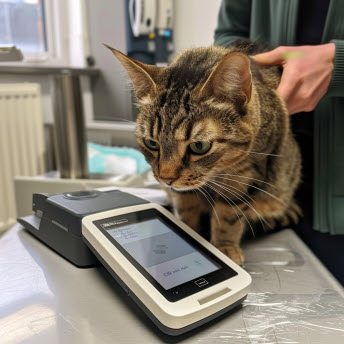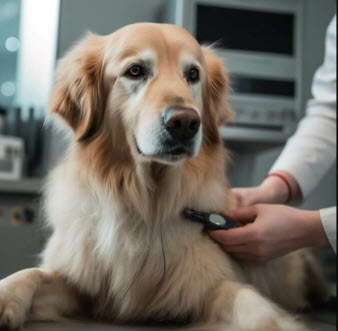Microchipping your pet has become a popular method of identification for pet owners in the UK. Not only is it a legal requirement for most pets, but it provides peace of mind knowing that your furry friend can be identified in case they are lost or stolen.
This article will cover everything you need to know about microchipping your pet in the UK, including the laws and regulations, reasons to microchip your pet, benefits for both pet owners and pets, the microchipping process, and maintenance of the microchip. By the end of this article, you will better understand whether microchipping is the right choice for you and your pet.
Table of Contents
- Introduction to Microchipping for Pets
- UK Laws and Regulations on Microchipping
- Reasons to Microchip Your Pet
- Benefits of Microchipping for Pet Owners
- Benefits of Microchip Insertion for Pets
- The Microchip Process: What to Expect
- Microchip Maintenance and Updating Information
- Conclusion: Is Microchipping Right for Your Pet?
- Where to Buy Microchip Products
- Frequently Asked Questions (FAQ)
- Microchip Databases
Introduction to Microchipping for Pets
If you’re a pet owner, chances are, you’ve heard of microchipping. Microchipping is a quick and easy way to permanently identify your furry friend. It’s a highly recommended way of ensuring your pet’s safety and well-being, especially when they get lost or stolen. In this article, we’ll discuss what microchipping is, how it works, the laws and regulations regarding it in the UK, and the reasons and benefits of microchipping your pet.
What is Microchipping?
Microchipping is the process of implanting a tiny computer chip, about the size of a grain of rice, under your pet’s skin, usually on the back of the neck. The chip contains a unique identification number that can be scanned and linked to your pet’s information, such as their name, contact information, and any medical needs they have.
How Does Microchipping Work?
When your pet is microchipped, a special scanner is used to read the chip’s unique identification number. The number can then be used to link to your pet’s information, which is kept in a national database. This database can be accessed by authorized veterinarians, animal welfare organizations, and authorities if your pet is found.
UK Laws and Regulations on Microchipping
Mandatory Microchipping in the UK
In the UK, microchipping for dogs became mandatory in 2016. It is now a legal requirement for all dogs over 8 weeks old to be microchipped and registered with their owner’s up-to-date contact details. The law also requires that puppies be microchipped before they’re sold or given to a new owner.
Enforcement of Microchipping Laws
The enforcement of microchipping laws is taken very seriously in the UK. Failing to microchip your dog can result in a fine of up to £500. If your dog is found without a microchip, you will have 21 days to get them chipped and registered.
Reasons to Microchip Your Pet
Preventing Loss or Theft of Your Pet
One of the biggest reasons to microchip your pet is to prevent loss or theft. If your pet is lost or stolen, having a microchip can increase the chances of it being returned to you. A microchip can also help prove ownership in the event of a dispute.
Identification During Emergencies
A microchip can also be critical in an emergency. If your pet is involved in an accident or becomes lost during a natural disaster, their chip can help emergency responders contact you and provide vital information about any medical issues your pet may have.
Travel Requirements with Pets
If you plan to travel with your pet, a microchip may be required for entry into certain countries. This can save you time and hassle when planning your trip.
Benefits of Microchipping for Pet Owners
Peace of Mind
One of the biggest benefits of microchipping your pet is peace of mind. Knowing that your pet can be identified and returned to you if it gets lost or stolen can alleviate a lot of anxiety and worry.
Cost-Effective Identification
Microchipping is relatively inexpensive compared to other forms of identification, such as collars and tags. Once your pet is chipped, there are no ongoing costs to keep them registered, making it a cost-effective form of identification.
Easy to Update Information
If your contact information changes, updating your pet’s information in the national database is quick and easy. You can do this online or by contacting the database providers directly. This means that your pet’s information is always up-to-date, increasing the chances of a speedy reunion if they get lost.
In conclusion, microchipping your pet is a simple and effective way to ensure their safety and well-being. From preventing loss or theft to easy identification during emergencies, microchipping provides many benefits for both pets and owners. Not to mention, it’s required by law for dogs in the UK!
Benefits of Microchip Insertion for Pets
Microchipping is a quick and easy procedure that involves inserting a tiny chip under your pet’s skin. This chip contains a unique identification number that is registered to your pet and you as the owner. Microchipping has numerous benefits for pets, including:
Reunification with Owners
One of the most significant benefits of microchipping your pet is the increased chance of being reunited with your pet if it becomes lost or stolen. Animal shelters and veterinary practices will check for a microchip and contact the registered owner if a lost or stray pet is found. This means that your pet can be returned to you quickly and safely.
Reduced Risk of Euthanasia
Microchipping can also reduce the risk of euthanasia for lost pets. If an animal remains unclaimed in a shelter, it may be put up for adoption, but if they are unable to find a new home, it may be put down. Ensuring your pet has a microchip increases the chances of being reunited with them and reduces the risk of your pet being put down unnecessarily.
Improved Animal Welfare
Microchip insertion also has significant benefits for animal welfare. If a lost pet is not microchipped, it may end up in an overcrowded animal shelter or even on the streets. Animals in these situations are at risk of injury, disease, and malnourishment. By microchipping your pet, you are doing your part to ensure your pet’s safety and well-being.
The Microchip Process: What to Expect
The microchipping procedure is quick, safe, and relatively painless. The process involves three main stages:
Choosing a Microchip
The first step in the microchip insertion process is choosing a suitable microchip. Various types of microchips are available, and your veterinarian can advise on which type is best for your pet.
Microchip Placement and Procedure
The second stage involves placing the microchip into your pet. The chip is inserted under the skin, usually between the shoulder blades. The procedure is similar to a regular vaccination and does not require anesthesia.
Microchip Registration
Once the microchip is inserted, it is essential to register the chip’s unique identification number and contact details with a reputable database. This information will allow animal shelters and veterinary practices to identify you as the owner of the animal.

Microchip Maintenance and Updating Information
After your pet has been microchipped, there are a few things to keep in mind to ensure the microchip remains effective.
Checking Microchip Functionality
Your veterinarian will check the microchip’s functionality during regular checkups. It is also important to ensure that the microchip is still in place, as it may move from the original location over time.
Updating Microchip Information
If you change your contact details, it is essential to update the microchip database. This will ensure that if your pet becomes lost, animal shelters and veterinary practices can contact you.
Conclusion: Is Microchipping Right for Your Pet?
Microchip insertion is a safe and easy way to ensure that your pet is identified and reunited with you if they become lost or stolen. The procedure is quick and relatively painless, and the benefits for pet owners, animals, and animal welfare are significant. If you are considering microchipping your pet, speak to your veterinarian to discuss whether it is the right choice for your pet.
In conclusion, microchipping your pet is vital in ensuring their safety and well-being. Not only is it a legal requirement in the UK, but it provides numerous benefits for both pet owners and pets. By taking the time to microchip your pet, you can rest assured that you are doing everything in your power to prevent the loss or theft of your furry friend.

Where to Buy Microchip Products
You can purchase microchips and scanners, plus ancillary equipment, at iDLOGIC (we are not affiliated)
You can access the microchip database at check-a-chip
Become a Microchip Implanter – take the DEFRA-approved course HERE
Frequently Asked Questions (FAQ)
Is microchipping painful for my pet?
No, the microchip process is quick and relatively painless for your pet. The microchip is inserted with a needle between the shoulder blades and can cause some discomfort, but most pets handle it well and experience no side effects.
Is microchip insertion expensive?
The cost of microchip insertion can vary depending on where you go and the type of microchip used. However, in general, it is a relatively low-cost procedure and is significantly less expensive than other forms of identification, such as tattoos or collars.
Can microchips be removed or fall out?
Microchips are designed to be a permanent form of identification and are unlikely to fall out or become dislodged. In rare cases, a microchip may migrate to a different part of the body, but it is still detectable with a compatible scanner.
Do I need to update my pet’s information if I move?
Yes, updating your pet’s microchip information is crucial anytime you move or change your contact information. This will ensure that your pet can be quickly and easily reunited with you if they are lost or stolen.
Need help with this article? Contact Us, and we will be happy to assist you.
Microchip Databases
Here are the microchip databases. you must make sure that your dog is registered on one of them (your vet will check).
- AnimalData
- Animal Microchips
- Animal Tracker
- Chipworks
- HomeAgain
- Identibase
- Lost Paws
- MicroChip Central
- MicroDogID
- My Animal Trace
- MyPet
- National Veterinary Data Service
- Pet Chip Register
- Pet Database
- Pet Identity UK
- Petlog
- PetScanner
- ProtectedPet
- SmartTrace
- Track Your Paws
- UK PETtrac MicroChip Database
- We Trace Pets




















